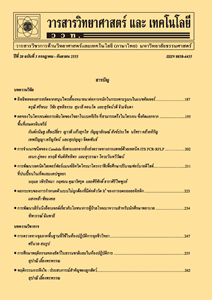ความหลากหลายและความสัมพันธ์ทางพันธุกรรมของยีสต์ทนแอลกอฮอล์จากลูกแป้งเหล้าในจังหวัดเชียงใหม่
Main Article Content
Abstract
Abstract
The aim of this study was to analyze the diversity and genetic relationship of ethanol tolerant yeasts isolated from rice wine starters (Loog-pang) in Chiang Mai province, Thailand. In total, 35 isolates from 9 samples of Loog-pang were identified by polymerase chain reaction (PCR) technique. The internal transcribed spacer 1 (ITS1) and ITS2 regions and the 5.8S ribosomal DNA (rDNA) region of the yeasts were amplified by using universal primers ITS1 and ITS4. According to the PCR product sequence, 21, 11, and 3 isolates were identified as Saccharomyces cerevisiae, Pichia kudriavzevii, and Candida glabrata, respectively. A phylogenetic analysis using neighbour-joining method was conducted in MEGA 7.0.18 using 2,000 replication (bootstrap). The phylogram of S. cerevisiae and P. kudriavzevii strains were divided into 3 and 2 groups, respectively, but the C. glabrata phylogram with bootstrap could not be carried out. Even though the results demonstrated that the yeasts from each sample of Loog-pang were genetically closely related but three isolates of C. glabrata from same district (San-sai) showed a high genetic diversity.
Keywords: ethanol tolerant yeast; rice wine starter; genetic relationship; ITS; DNA marker
Article Details
References
[2] Schuller, D., Valero, E., Dequin, S. and Casal, M., 2004, Survey of molecular methods for the typing of wine yeast strains, FEMS Microbiol. Lett. 231: 19-26.
[3] Richard, G., Kerrest, A. and Dujon, B., 2008, Comparative genomics and molecular dynamics of DNA repeats in eukaryotes, Microbiol. Mol. Biol. Rev. 72: 686-727.
[4] Kurtzman, C.P., 2015, Identification of food and beverage spoilage yeasts from DNA sequence analyses, Int. J. Food Microbiol. 213: 71-88.
[5] Ghindea, R., Csutak, O., Stoica, I., Ionescu, R., Soare, S., Pelinescu, D., Nohit, A.M., Creangă, O., Vassu, T., 2004, Molecular taxonomy techniques used for yeast identification, Bacteriol Virusol Parazitol Epidemiol 49: 105-113.
[6] White, T.J., Bruns, T., Lee, S. and Taylor, J.W., 1990, Amplification and Direct Sequencing of Fungal Ribosomal RNA Genes for Phylogenetics, pp. 315-322, In Innis, M.A., Gelfand, D.H., Sninsky, J.J. and White, T.J., PCR Protocols: A Guide to Methods and Applications, Academic Press, Inc., New York.
[7] Ma, M. And Liu, Z.L., 2010, Mechanisms of ethanol tolerance in Saccharomyces cerevisiae, Appl. Microbiol. Biotechnol. 87: 829-845.
[8] Stanley, D., Bandara, A., Fraser, S., Chambers, P.J. and Stanley G.A., 2010, The ethanol stress response and ethanol tolerance of Saccharomyces cerevisiae. J. Appl. Microbiol. 109: 13-24.
[9] Zoecklein, B.W., Fugelsang, K.C., Gump, B.H. and Nury, F.S., 1995, Wine Analysis and Production, Kluwer Academic Publishers, New York.
[10] Jeyaram, K., Singh, W.M., Capece, A. and Romano, P., 2008, Molecular identification of yeast species associated with 'Hamei' – a traditional starter used for rice wine production in Manipur, India, Int. J. Food Microbiol. 124: 115-125.
[11] Aponte, M. and Blaiotta, G., 2016, Potential role of yeast strains isolated from grapes in the production of Taurasi DOCG, Front. Microbiol. 7: 809.
[12] Watanabe, I., Nakamura, T. and Shima, J., 2009, Characterization of a spontaneous flocculation mutant derived from Candida glabrata: A useful strain for bioethanol production, J. Biosci. Bioeng. 107: 379-382.
[13] Jeyaram, K., Tamang, J.P., Capece, A. and Romano, P., 2011, Geographical markers for Saccharomyces cerevisiae strains with similar technological origins domesticated for rice-based ethnic fermented beverages production in North East India, Antonie Van Leeuwenhoek 100: 569-578.


